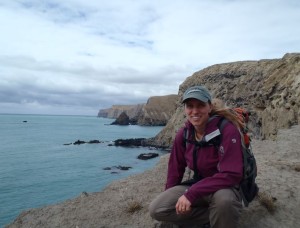
The typical Hollywood depiction of a volcano might be visually stunning, but it’s not very accurate.
Dr. Kari Cooper, a geologist at The University of California, Davis, provides a more realistic portrayal of what happens deep in the belly of a volcano.
Dr. Kari Cooper is an associate professor at The University of California Davis’ Department of Earth and Planetary Sciences. Her research focuses on geochemistry, volcanology, and igneous petrology, on timescales of magmatic processes, from melt generation and transport to storage and crystallization in crustal reservoirs, and on tracing the distribution and abundance of crustal materials that have been recycled through the mantle.
Kari Cooper – Reservoirs of Magma
Magma reservoirs are complex, active environments.
Hollywood might portray a reservoir as a vast open chamber with a pool of bubbling magma at the bottom. In reality, these reservoirs are located miles beneath the surface, where the pressures are immense.
The state of the magma depends on temperature – it is completely molten at high temperature, but as it cools it progressively crystallizes and at relatively low temperatures the percentage of crystals is so high that they form a rigid network called a “magma mush”.
We know that bodies of hot, eruptible magma must exist sometimes below the surface, or we would never see eruptions. But there is increasing evidence that these reservoirs spend a lot of their time as a crystal mush. So how long is “a lot”?
 The key to answering this question is in the crystals, which can survive for hundreds of thousands of years deep within the reservoirs, acting as tiny recorders of their environment, before they are eventually erupted. My colleague Adam Kent and I used these crystal records to study Mount Hood, Oregon.
The key to answering this question is in the crystals, which can survive for hundreds of thousands of years deep within the reservoirs, acting as tiny recorders of their environment, before they are eventually erupted. My colleague Adam Kent and I used these crystal records to study Mount Hood, Oregon.
The surprising result is that the Mt Hood reservoir spends the vast majority of its time as a relatively immobile crystal mush, and partial data sets from many similar volcanoes suggests that this mode of behavior is common.
This is important for two reasons. First, in terms of volcanic hazards, this and other research suggests that going from a rigid mush to an eruptible magma can happen quickly, so we have to be prepared with monitoring systems in place before we see signs of unrest.
Second, our new results force us to view magma reservoirs differently, as largely solid bodies most of the time. This presents a new problem because magma reservoirs are very dynamic places.
Thus, understanding the physical state of magmas beneath the surface has important implications: interpreting data for hazards and forecasting, understanding how magmas are generated and how they change over time. Eventually we will get answers to these questions as future research provides a better view of a magma reservoir.
Read More: ABC Science: New clues to predicting volcanic eruptions

Comments
2 responses to “Kari Cooper, UC Davis – Reservoirs of Magma”
Hello I am a teacher geology from lran
send me some book which Should give me help in geochemistry